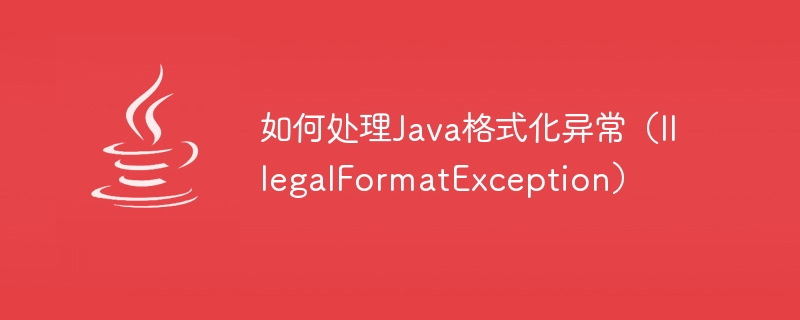Home >Java >javaTutorial >How to handle Java formatting exception (IllegalFormatException)
How to handle Java formatting exception (IllegalFormatException)
- WBOYWBOYWBOYWBOYWBOYWBOYWBOYWBOYWBOYWBOYWBOYWBOYWBOriginal
- 2023-08-19 18:48:422087browse

How to handle Java format exception (IllegalFormatException)
In Java programming, formatting strings is a common operation. However, when we use format strings, we sometimes encounter IllegalFormatException exceptions. This exception indicates a syntax error in the format string or a parameter mismatch. In this article, we will learn how to identify and handle this exception and give some example code.
First, let us look at an example of generating an IllegalFormatException exception:
public class FormatExceptionExample {
public static void main(String[] args) {
String name = "John";
int age = 25;
String message = String.format("My name is %d. I am %s years old.", age, name);
System.out.println(message);
}
}In the above example, we use the format string "%d" to represent an integer, but in fact What we pass is a string type parameter. This will result in an IllegalArgumentException because the parameter types do not match.
In order to avoid the occurrence of this exception, we can use the exception handling mechanism in the code to catch and handle IllegalFormatException. Here is a modified example:
public class FormatExceptionExample {
public static void main(String[] args) {
String name = "John";
int age = 25;
try {
String message = String.format("My name is %s. I am %d years old.", name, age);
System.out.println(message);
} catch (IllegalFormatException e) {
System.out.println("格式化字符串错误: " + e.getMessage());
}
}
}In this example, we use a try-catch statement block to catch IllegalFormatException that may occur. When an exception occurs, the program executes the code in the catch block and prints out the exception information. In this way, we can get more detailed error information and be able to handle specific errors.
In addition to using the exception handling mechanism, we can also use the string format verification method (such as the checkFormat method) to check whether the formatted string is valid before performing the formatting operation. The following is an example of using the checkFormat method:
public class FormatExceptionExample {
public static void main(String[] args) {
String name = "John";
int age = 25;
String format = "My name is %s. I am %d years old.";
if (checkFormat(format)) {
String message = String.format(format, name, age);
System.out.println(message);
} else {
System.out.println("格式化字符串错误");
}
}
public static boolean checkFormat(String format) {
try {
String.format(format, "", 0); // 尝试格式化一个空字符串和0
return true;
} catch (IllegalFormatException e) {
return false;
}
}
}In this example, we define a checkFormat method to check whether the formatted string is valid. We try to use an empty string and 0 to format the string. If no exception occurs when performing this operation, it means that the formatted string is valid. Otherwise, return false.
By catching formatting exceptions and using format verification methods, we can handle and respond to formatting exceptions more flexibly. Of course, the specific processing methods need to be adjusted according to the actual situation.
To sum up, you can handle Java formatting exceptions (IllegalFormatException) through the following steps: use the exception handling mechanism to catch the exception, obtain error information and prompt the user, or use the format verification method to check the formatting before performing the formatting operation. Whether the string is valid. This can help us handle and resolve this exception more effectively and improve the robustness of the program.
The above is the detailed content of How to handle Java formatting exception (IllegalFormatException). For more information, please follow other related articles on the PHP Chinese website!
Related articles
See more- Detailed explanation of error and exception handling on try-except usage in Python
- Detailed explanation of error handling and exception handling mechanisms in PHP
- How does JavaScript handle exceptions? Try method for exception handling
- Introduction to global exception handling of Spring Cloud Gateway (code example)
- Let's talk about THINKPHP debugging mode and exception handling

